It was overcast all day so the pictures aren't as bright as I'd hoped. I also took pictures of many of the informational displays that were set up around the site. After a bit of Photoshop work, I was able to make most of them readable. Since I have so many pictures that I wanted to include from our visit to Trinity, I decided to put the informational displays in their own blog, which will follow this one (look at Trinity 2).
Also, I have started posting my pictures on my own web space, instead of on bloggers site. This may make them a bit slower to load, but that way I can post as many photos as I like. If this causes anyone any problems, please let me know (this is still in the experimental stages for me).
And now on to our visit to the Trinity Site.
On Friday night, it got incredibly windy, and when it's incredibly windy in New Mexico, that's saying something. We even had a bit of rain, so I didn't sleep really well. But we weren't going to let a little inclement weather stop us from visiting the Trinity Site. As it turns out, it was better that it be cold rather than hot as I prefer putting on a coat to sweating under a hot New Mexico sun.
For those of you not familiar with the Site, this is where the United States exploded the very first Atomic Bomb on July 16, 1945. Called the Trinity Site, it was designated a National Monument in 1975. Even though it's a National Monument, it's located smack dab in the middle of an Army base, and is only open two days a year, the first Saturday in April and the first in October.
Last year we missed it by just a few days, so we made plans to make sure we could attend this year.
We started out early, since it was about a seventy mile drive to the site. Once again, we marveled at the difference in landscape as we drove along. We traveled through the lava flows where we are camping to red rock canyons and then into flat desert with dunes and mesquite. These mountains were almost at the entry to the base, at what is called Stallion Gate.
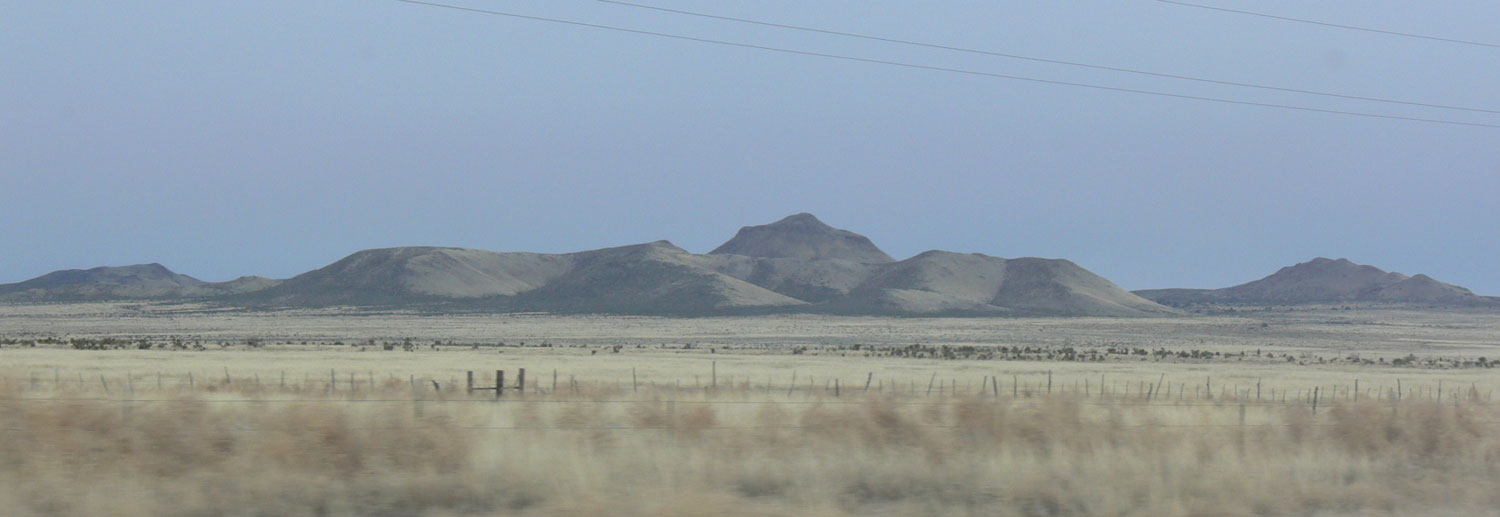 We passed through the security checkpoint, where they gave us a nice comprehensive booklet on the site. We then drove on for another seventeen miles before we reached the parking lot for Ground Zero.
We passed through the security checkpoint, where they gave us a nice comprehensive booklet on the site. We then drove on for another seventeen miles before we reached the parking lot for Ground Zero.The National Monument consists of two parts, the actual Ground Zero where the bomb was exploded and the Schmidt/McDonald Ranch House where the plutonium core of the bomb was actually assembled. We had read that the ranch house can get quite crowded later in the tour (the site is only open for six hours), so we decided to visit there first.
This house is a wonderful old place, built in 1913 by a German immigrant named Franz Schmidt. He married Miss Esther Holmes of Pearsall, Texas. They lived here and worked the ranch with their three children.
 I was as intrigued with the family history of the house as I was the military aspect. The house is pretty much as it was when the army was using it, but also very much like it was when the Schmidt family lived there.
I was as intrigued with the family history of the house as I was the military aspect. The house is pretty much as it was when the army was using it, but also very much like it was when the Schmidt family lived there.Here we were, literally out in the middle of nowhere, and you really got the sense that people had made their home here. In 2003 Frances, one of the last remaining Schmidt children visited the home and shared many stories of what life was like growing up out in here in the desert. I would have loved the opportunity to hear her stories.
In addition to the house, there are still the remains of the stone barn where the family lived while the house was under construction. This shot shows what remains of the original barn.
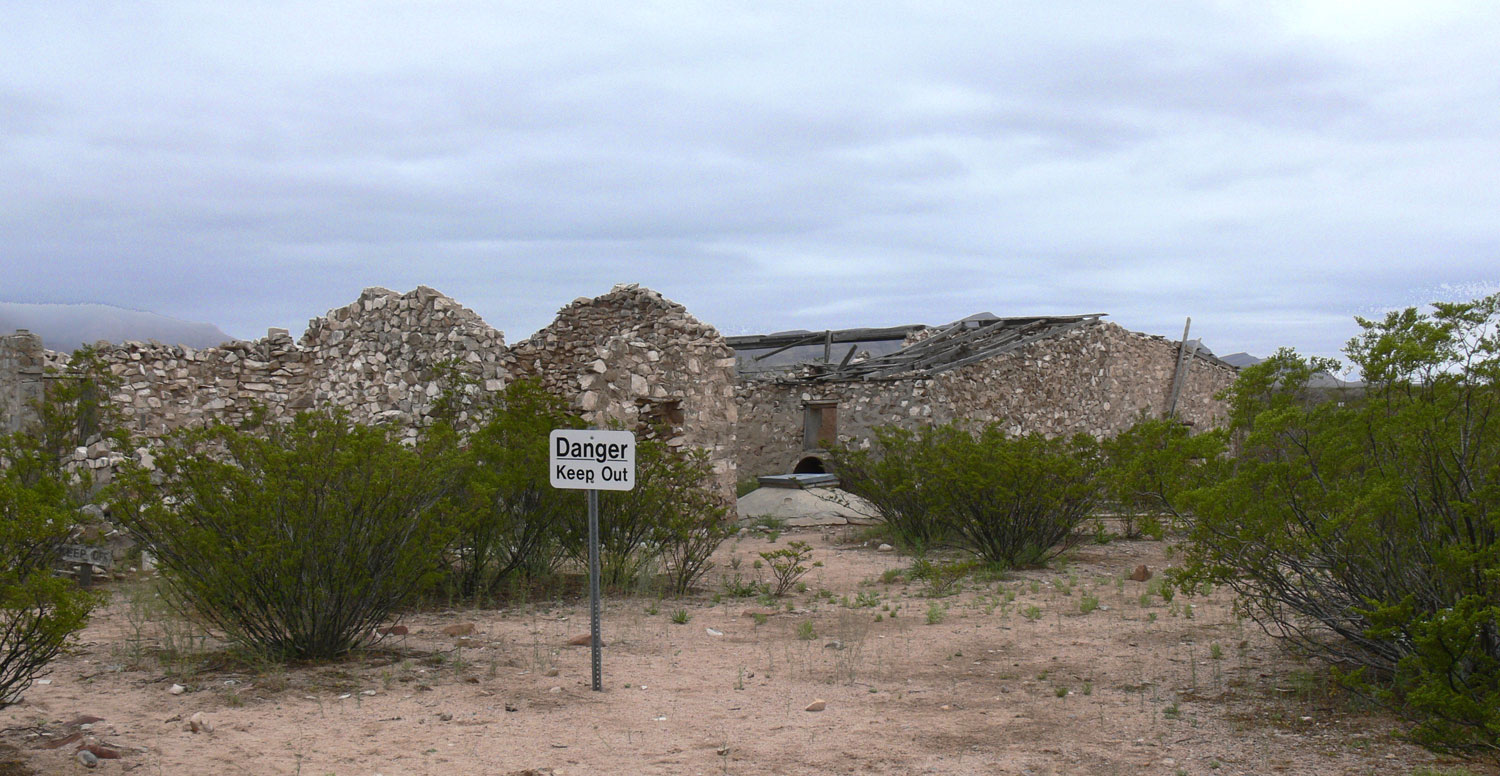 Here's one more shot taken from the back of the house. I'm including it so you can get an idea of the isolation of this place. In reading about the family there was a comment that they would get supplies twice a year. Traveling as we do, keeping up with groceries and supplies is a constant challenge, but the visit to this homestead made me realize how completely spoiled we are in these modern times.
Here's one more shot taken from the back of the house. I'm including it so you can get an idea of the isolation of this place. In reading about the family there was a comment that they would get supplies twice a year. Traveling as we do, keeping up with groceries and supplies is a constant challenge, but the visit to this homestead made me realize how completely spoiled we are in these modern times. This shot shows the entrance to the master bedroom, which was later used as the "clean room" where the Army assembled the plutonium core of the bomb. They covered the doors and windows with plastic and tape to keep it as clean as possible. Wouldn't the folks who built this bomb be amazed at our current "clean" rooms?
This shot shows the entrance to the master bedroom, which was later used as the "clean room" where the Army assembled the plutonium core of the bomb. They covered the doors and windows with plastic and tape to keep it as clean as possible. Wouldn't the folks who built this bomb be amazed at our current "clean" rooms?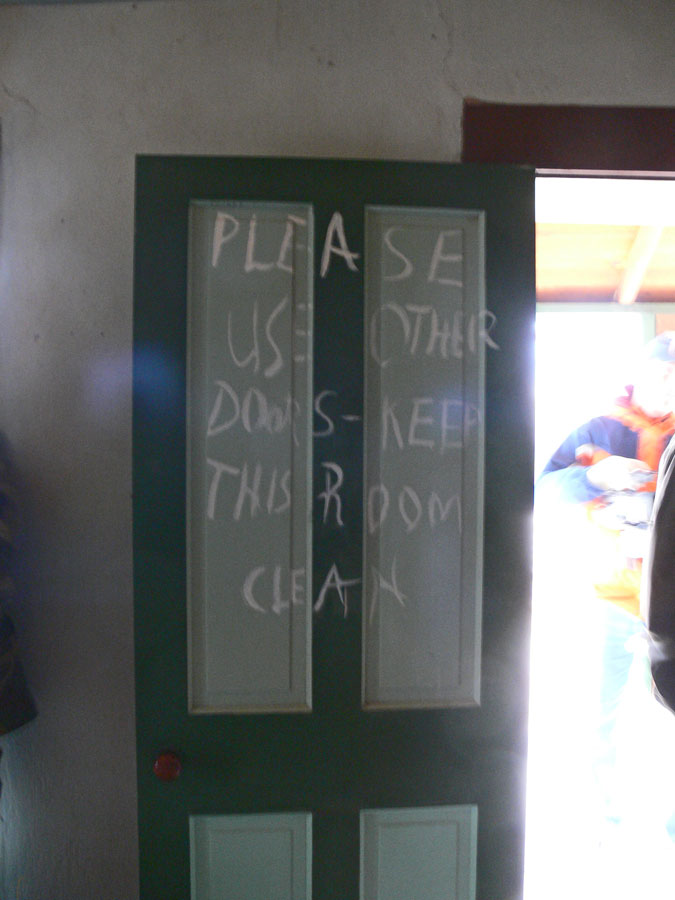 Here's a bit of detail I wanted to include. This is the the stenciling near the roof line of the original living room. While this has obviously been touched up, I love the warmth it brings to the living room. The original stenciling was done by a ranch hand named Mike Walsh. According to Frances, he also took care of the family car, which was the first one in the area.
Here's a bit of detail I wanted to include. This is the the stenciling near the roof line of the original living room. While this has obviously been touched up, I love the warmth it brings to the living room. The original stenciling was done by a ranch hand named Mike Walsh. According to Frances, he also took care of the family car, which was the first one in the area.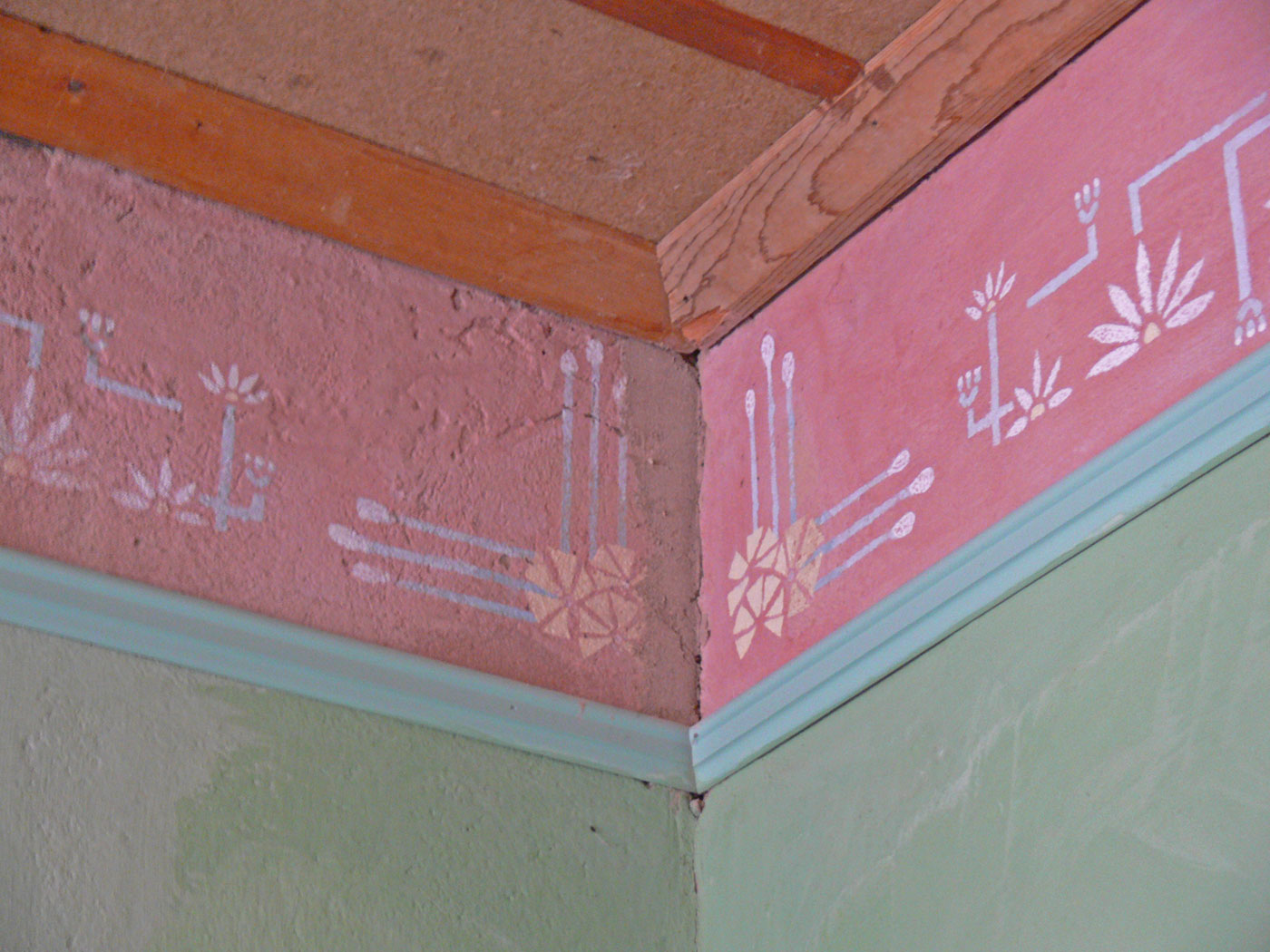 This was shot in the hallway between the main house and the back ice house, which was mostly under ground. As it wasn't too crowded, I took some time and tried to imagine life out here one hundred years ago. I wonder what thoughts went through these women's minds as they looked out on this landscape from their home?
This was shot in the hallway between the main house and the back ice house, which was mostly under ground. As it wasn't too crowded, I took some time and tried to imagine life out here one hundred years ago. I wonder what thoughts went through these women's minds as they looked out on this landscape from their home?There is history that there were extensive gardens and trees, most likely planted and tended by the women of the ranch. It must have been a lovely place to live.
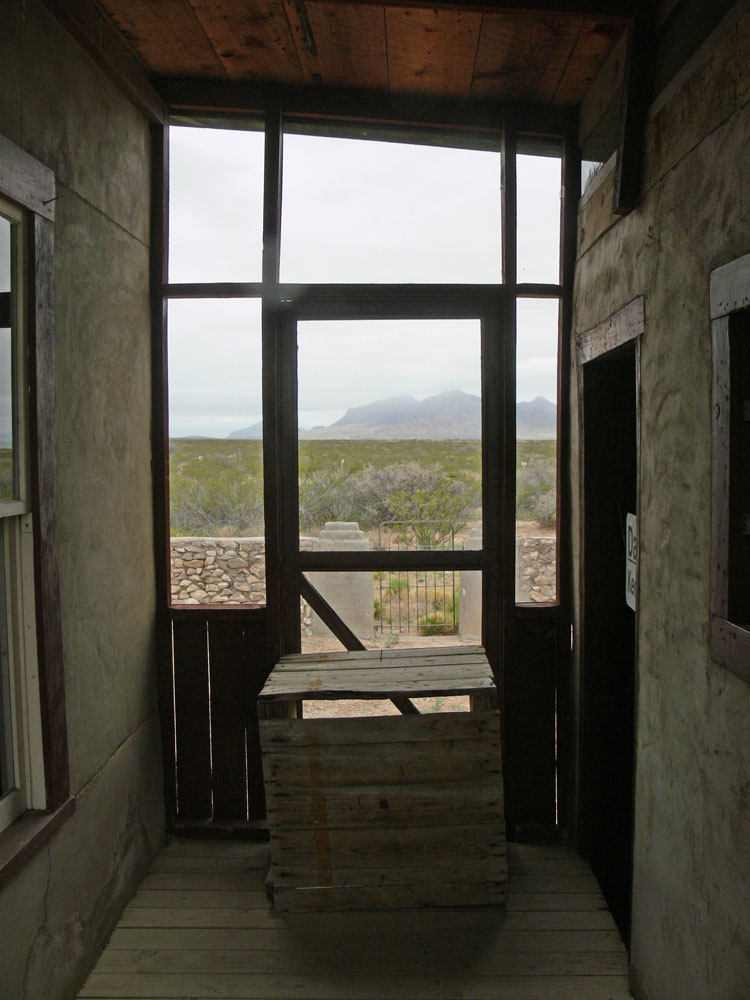 This photo shows the remains of what was once a wind generator which supplied power to the ranch. At the bottom of the photo is the divided water storage tank. When the military arrived, they found the water at the ranch was unsuitable for drinking, so the troops used one of these tanks as a swimming pool.
This photo shows the remains of what was once a wind generator which supplied power to the ranch. At the bottom of the photo is the divided water storage tank. When the military arrived, they found the water at the ranch was unsuitable for drinking, so the troops used one of these tanks as a swimming pool.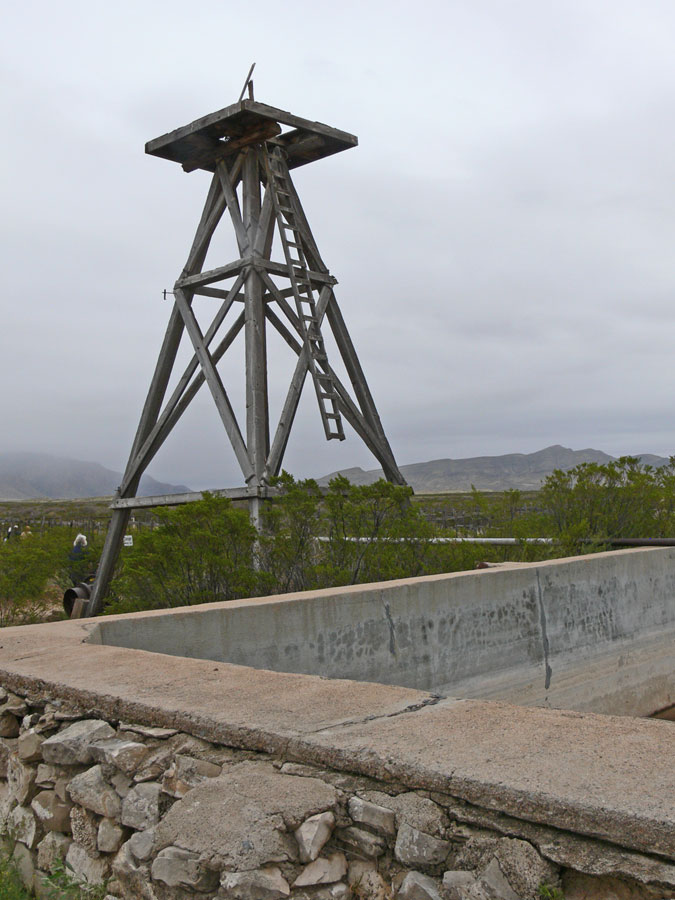
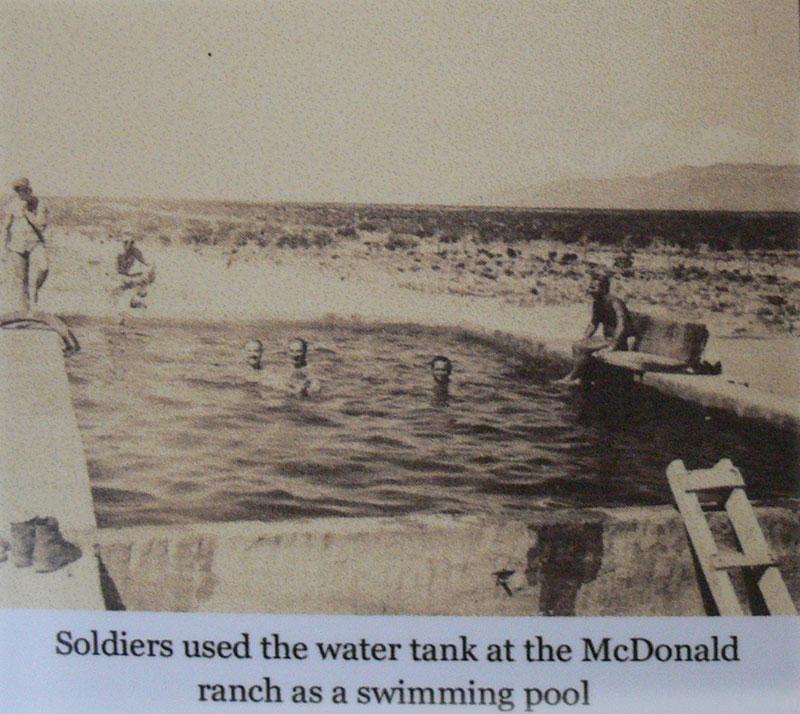
Once again, a shot of the area around the house. I love these fences, which we still see throughout New Mexico. I find them quite beautiful and organic, as opposed to modern fences.
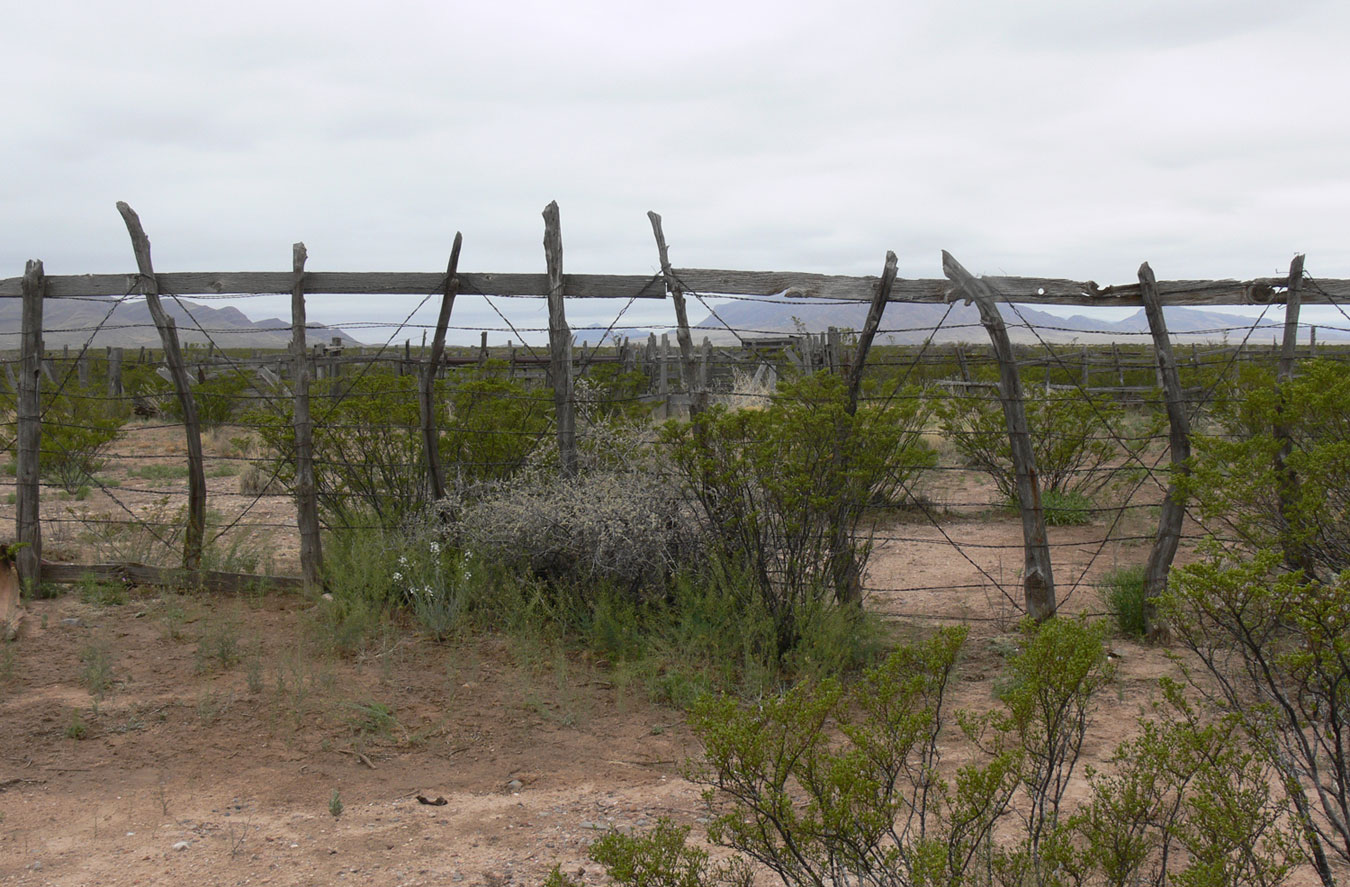 I had to include this shot, which shows some of the spring flowers just peeking out. I know I keep talking about the flowers here in the desert, but they never fail to delight me.
I had to include this shot, which shows some of the spring flowers just peeking out. I know I keep talking about the flowers here in the desert, but they never fail to delight me.Keep in mind that this house is two miles from Ground Zero and survived the blast (with the exception of blown out windows and a fallen chimney). When I see the way nature rebounds, I am constantly amazed. It kind of reminded me of our visit to Mt St Helens last year. If you're interested in reading about that area, my entry can be read here.
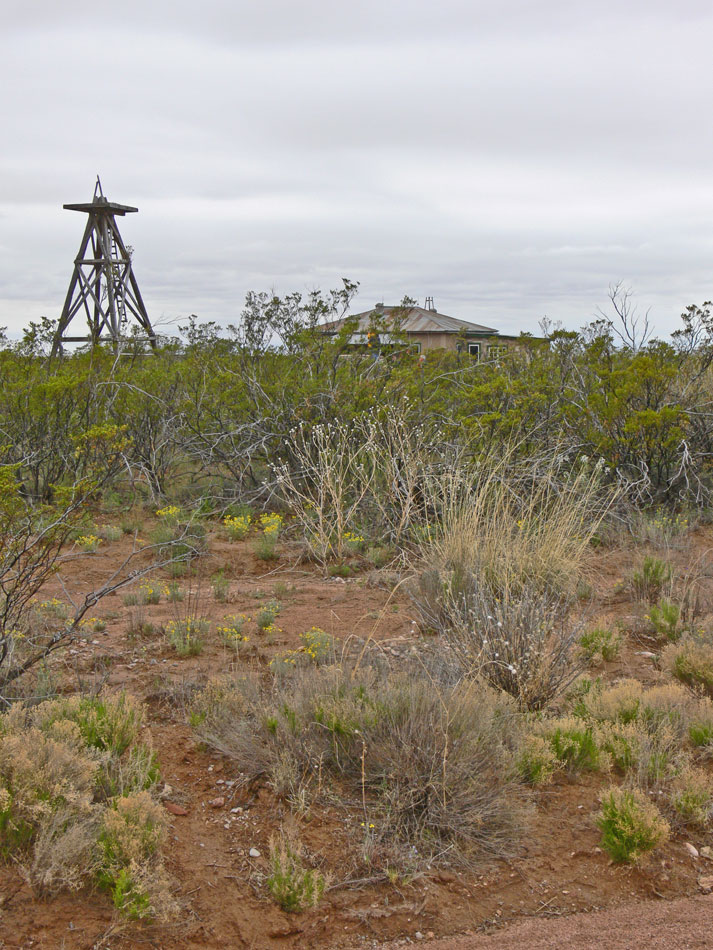 This is part of a monument at the Schmidt/McDonald house. I love this logo, they use it all over the place here at the Trinity Site. I was hoping to get a pin or a patch with this logo, but there were none to be had.
This is part of a monument at the Schmidt/McDonald house. I love this logo, they use it all over the place here at the Trinity Site. I was hoping to get a pin or a patch with this logo, but there were none to be had.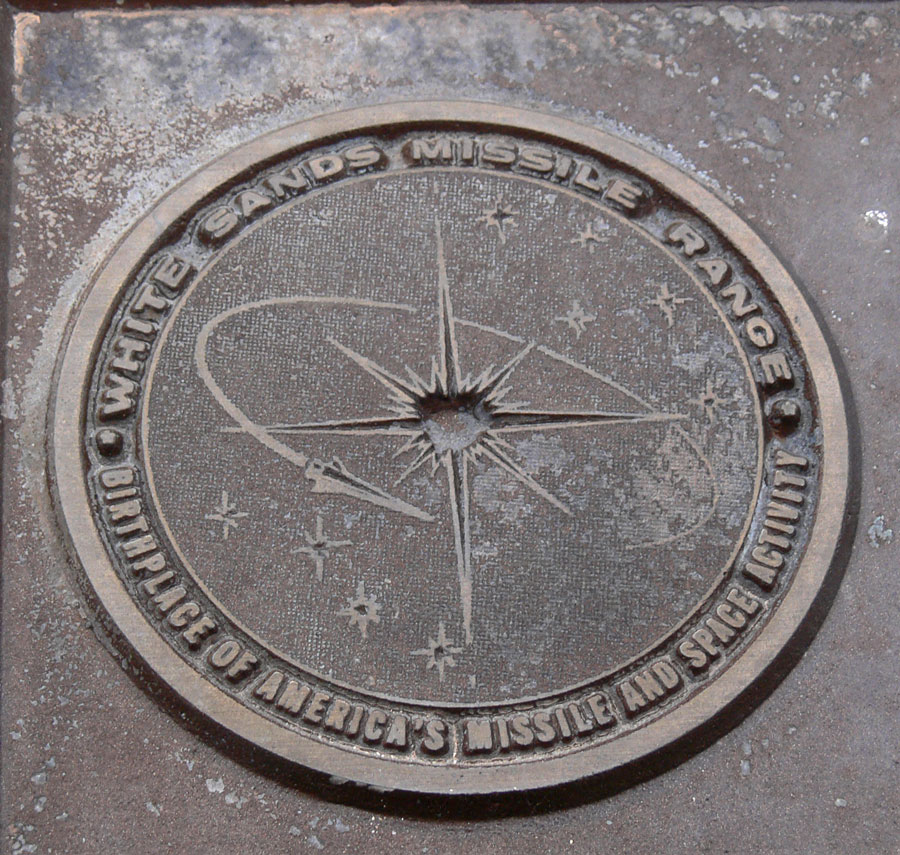 After this part of the tour, we got on a bus and went back to Ground Zero.
After this part of the tour, we got on a bus and went back to Ground Zero.Here;s a shot of Terry and I standing in the remains of Jumbo.
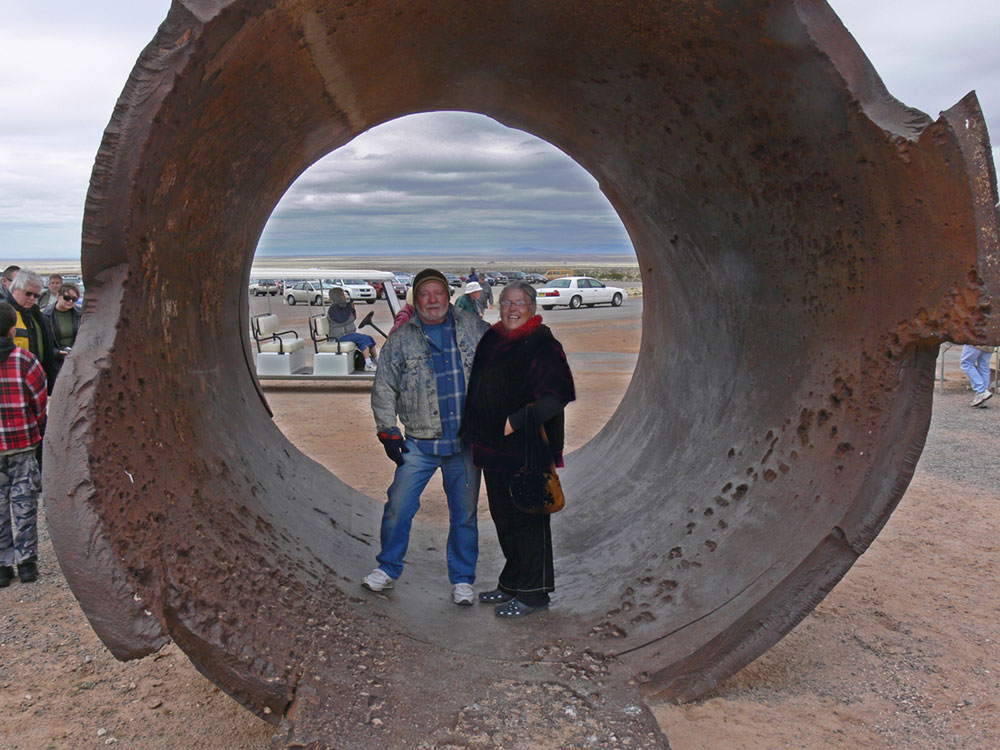 Jumbo was built specifically for the Trinity Site. Originally weighing in at 214 tons, it stood 25 feet long and 12 feet in diameter. The walls were 12 inches thick.
Jumbo was built specifically for the Trinity Site. Originally weighing in at 214 tons, it stood 25 feet long and 12 feet in diameter. The walls were 12 inches thick.Manufactured in Ohio, it was brought to Pope, New Mexico by train. A specially built trailer with 64 wheels was built just to bring Jumbo out to Trinity. Originally it was planned that the Atomic Bomb would be placed in Jumbo, but plans changed and it was moved to a spot under a steel tower about 800 yards from Ground Zero. When the bomb was exploded, the tower was disintegrated, but Jumbo survived intact.
Then in 1946, in another test, the Army placed eight 500 pounds bombs inside of Jumbo. Well, the old boy couldn't survive that one and the ends blew off, leaving it as you see it today.
It was quite an attraction during our visit.
Now it was time for us to trek out to Ground Zero.
When the bomb was exploded, it was placed on top of a 100 foot tower to simulate an aerial explosion. When detonated, it vaporized the tower and left a scooped out depression full of melted sand which had turned green from the blast. The resulting "glass" is called trinitite and was found for miles around in the desert. Now it is illegal to remove any trinitite from the site, but pieces are for sale in rock shops in the area.
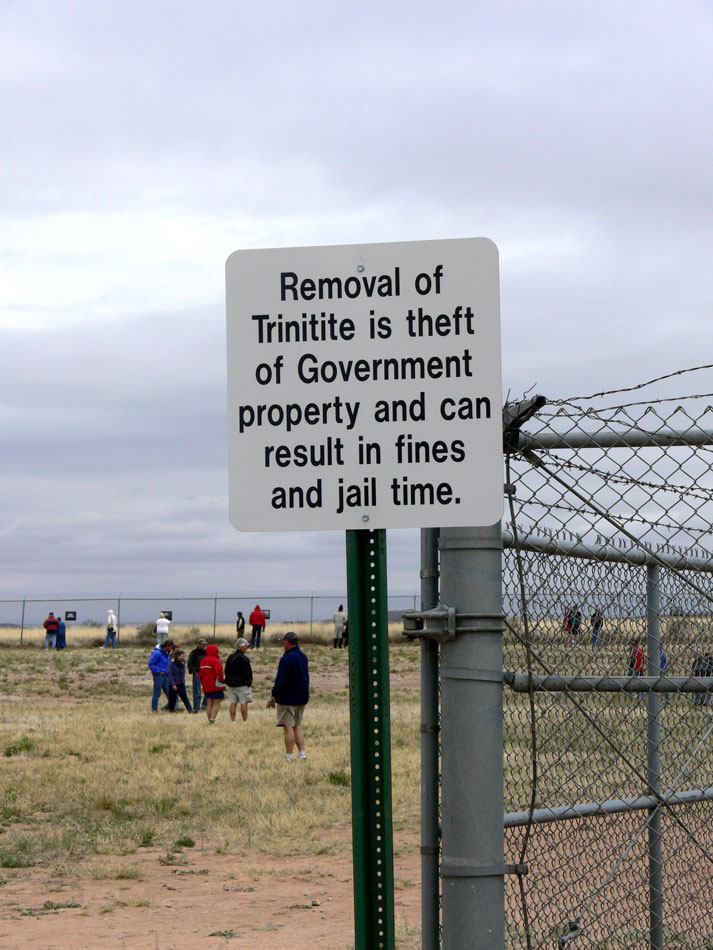 A display of trinitite, showing the different shapes and colors. The two tiny round pieces were formed when desert sand was scooped up by the blast. Once liquified and thrown into the air, the sand acted just like water droplets in a cloud. When they became too heavy to stay aloft, they fell to the earth as trinitite drops.
A display of trinitite, showing the different shapes and colors. The two tiny round pieces were formed when desert sand was scooped up by the blast. Once liquified and thrown into the air, the sand acted just like water droplets in a cloud. When they became too heavy to stay aloft, they fell to the earth as trinitite drops. This monument stands squarely at Ground Zero. It's constructed of lava (probably from right where we are camping).
This monument stands squarely at Ground Zero. It's constructed of lava (probably from right where we are camping). This is the plaque on the obelisk.
This is the plaque on the obelisk. And I couldn't resist, Here are spring flowers, blooming within ten feet of Ground Zero.
And I couldn't resist, Here are spring flowers, blooming within ten feet of Ground Zero. The horror of the bomb is undeniable, but this spot does deserve a place in history and I'm glad we got the chance to visit. If you're in New Mexico at the right time of year, I think it's an important place to experience.
The horror of the bomb is undeniable, but this spot does deserve a place in history and I'm glad we got the chance to visit. If you're in New Mexico at the right time of year, I think it's an important place to experience.Also, if you are ever in Albuquerque, make sure to visit the Atomic Museum. It's another thought provoking attraction and one that shouldn't be missed.
After our drive home (we were exhausted, this was a jam packed day), we were treated to more wonderful skies. This mountain is off to the east of the Valley of Fires and often sports a halo of clouds, as shown here.
 And here's our little rig, as she looked when we drove up, with the sun setting behind her.
And here's our little rig, as she looked when we drove up, with the sun setting behind her.We had a wonderful day but it sure was great to be home.

1 comment:
It's Stephanie from macresource.com . How absolutely funny! I was at Trinity on the same day as you!!! What a small world. What a cold day that was.
Post a Comment